Soyuz TMA-10 / ISS Expedition 15
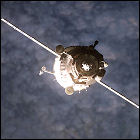 The fifteenth full-time crew of the International Space Station lifts off from Russia’s Baikonur Cosmodrome aboard Soyuz TMA-10. Oleg Kotov and Fyodor Yurchikhin take up residence on the ISS for 196 days. Arriving with them on the ISS for an 11-day stay is space tourist Charles Simonyi, a Microsoft software engineer (whose successes included such widely-used software as Microsoft Word and Excel), who returns to Earth aboard Soyuz TMA-9 with the Expedition 14 crew. Like other “space tourists” before him, he has paid for his own Soyuz seat and mission training. When Kotov and Yurchikhin return in October 2007, the Soyuz suffers a dangerous malfunction, failing to jettison its service module; the result is an off-balance spacecraft that re-enters the atmosphere nose-first, exposing under-insulated portions of the vehicle to the heat of re-entry. The crew manages a survivable landing, but news of the incident is kept quiet by the Russian space program until a similar mishap occurs aboard the next Soyuz flight.
The fifteenth full-time crew of the International Space Station lifts off from Russia’s Baikonur Cosmodrome aboard Soyuz TMA-10. Oleg Kotov and Fyodor Yurchikhin take up residence on the ISS for 196 days. Arriving with them on the ISS for an 11-day stay is space tourist Charles Simonyi, a Microsoft software engineer (whose successes included such widely-used software as Microsoft Word and Excel), who returns to Earth aboard Soyuz TMA-9 with the Expedition 14 crew. Like other “space tourists” before him, he has paid for his own Soyuz seat and mission training. When Kotov and Yurchikhin return in October 2007, the Soyuz suffers a dangerous malfunction, failing to jettison its service module; the result is an off-balance spacecraft that re-enters the atmosphere nose-first, exposing under-insulated portions of the vehicle to the heat of re-entry. The crew manages a survivable landing, but news of the incident is kept quiet by the Russian space program until a similar mishap occurs aboard the next Soyuz flight.
Soyuz TMA-9 / Expedition 14
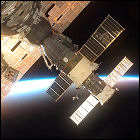 The fourteenth full-time crew of the International Space Station lifts off from Russia’s Baikonur Cosmodrome aboard Soyuz TMA-9. Mikhail Tyurin and Michael López-Alegría take up residence on the ISS for 215 days; with the American space shuttle fleet back in action, longer ISS stays with larger crews are once again possible.. Arriving with them on the ISS for a nine-day stay is Iranian-born telecommunications entrepreneur (and Ansari X-Prize founder) Anousheh Ansari, who returns to Earth aboard Soyuz TMA-8 with the Expedition 13 crew. Like other “space tourists” before her, she has paid for her own Soyuz seat and mission training.
The fourteenth full-time crew of the International Space Station lifts off from Russia’s Baikonur Cosmodrome aboard Soyuz TMA-9. Mikhail Tyurin and Michael López-Alegría take up residence on the ISS for 215 days; with the American space shuttle fleet back in action, longer ISS stays with larger crews are once again possible.. Arriving with them on the ISS for a nine-day stay is Iranian-born telecommunications entrepreneur (and Ansari X-Prize founder) Anousheh Ansari, who returns to Earth aboard Soyuz TMA-8 with the Expedition 13 crew. Like other “space tourists” before her, she has paid for her own Soyuz seat and mission training.
Soyuz TMA-8 / ISS Expedition 13
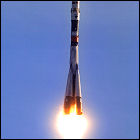 The thirteenth full-time crew of the International Space Station lifts off from Russia’s Baikonur Cosmodrome aboard Soyuz TMA-8. Pavel Vinogradov and Jeffrey Williams take up residence on the ISS for 182 days; during their stay, the ISS crew expands to three with the arrival of Thomas Reiter aboard space shuttle Discovery, marking the remaining shuttle fleet’s temporary return to service. Arriving with them on the ISS for a nine-day stay is Brazilian astronaut Marcos Pontes, who returns to Earth aboard Soyuz TMA-7 with the Expedition 12 crew.
The thirteenth full-time crew of the International Space Station lifts off from Russia’s Baikonur Cosmodrome aboard Soyuz TMA-8. Pavel Vinogradov and Jeffrey Williams take up residence on the ISS for 182 days; during their stay, the ISS crew expands to three with the arrival of Thomas Reiter aboard space shuttle Discovery, marking the remaining shuttle fleet’s temporary return to service. Arriving with them on the ISS for a nine-day stay is Brazilian astronaut Marcos Pontes, who returns to Earth aboard Soyuz TMA-7 with the Expedition 12 crew.
Soyuz TMA-7 / ISS Expedition 12
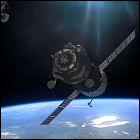 The twelfth full-time crew of the International Space Station lifts off from Russia’s Baikonur Cosmodrome aboard Soyuz TMA-7. Valery Tokarev and William McArthur take up residence on the ISS for 189 days. Arriving with them on the ISS for a nine-day stay is space tourist and entrepreneur Gregory Olsen, who personally funded his own trip aboard the Soyuz and returns to Earth aboard Soyuz TMA-6 with the Expedition 11 crew.
The twelfth full-time crew of the International Space Station lifts off from Russia’s Baikonur Cosmodrome aboard Soyuz TMA-7. Valery Tokarev and William McArthur take up residence on the ISS for 189 days. Arriving with them on the ISS for a nine-day stay is space tourist and entrepreneur Gregory Olsen, who personally funded his own trip aboard the Soyuz and returns to Earth aboard Soyuz TMA-6 with the Expedition 11 crew.
Soyuz TMA-6 / ISS Expedition 11
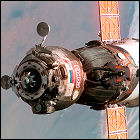 The eleventh full-time crew of the International Space Station lifts off from Russia’s Baikonur Cosmodrome aboard Soyuz TMA-6. Sergei Krikalev and John Phillips take up residence on the ISS for 179 days. Arriving with them on the ISS for a nine-day stay is astronaut Roberto Vittori, who returns to Earth aboard Soyuz TMA-5 with the Expedition 10 crew.
The eleventh full-time crew of the International Space Station lifts off from Russia’s Baikonur Cosmodrome aboard Soyuz TMA-6. Sergei Krikalev and John Phillips take up residence on the ISS for 179 days. Arriving with them on the ISS for a nine-day stay is astronaut Roberto Vittori, who returns to Earth aboard Soyuz TMA-5 with the Expedition 10 crew.
Soyuz TMA-5 / ISS Expedition 10
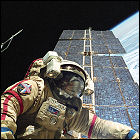 The tenth full-time crew of the International Space Station lifts off from Russia’s Baikonur Cosmodrome aboard Soyuz TMA-5. Salizhan Sharipov and Leroy Chiao take up residence on the ISS for 192 days. Arriving with them on the ISS for a nine-day stay is cosmonaut Yuri Shargin, who returns to Earth aboard Soyuz TMA-4 with the Expedition 9 crew.
The tenth full-time crew of the International Space Station lifts off from Russia’s Baikonur Cosmodrome aboard Soyuz TMA-5. Salizhan Sharipov and Leroy Chiao take up residence on the ISS for 192 days. Arriving with them on the ISS for a nine-day stay is cosmonaut Yuri Shargin, who returns to Earth aboard Soyuz TMA-4 with the Expedition 9 crew.
Soyuz TMA-4 / ISS Expedition 9
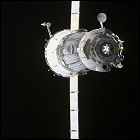 The ninth full-time crew of the International Space Station lifts off from Russia’s Baikonur Cosmodrome aboard Soyuz TMA-4. Gennady Padalka and Michael Fincke take up residence on the ISS for 187 days. Arriving with them on the ISS for a ten-day stay is Dutch astronaut Andre Kuipers, who returns to Earth aboard Soyuz TMA-3 with the Expedition 8 crew.
The ninth full-time crew of the International Space Station lifts off from Russia’s Baikonur Cosmodrome aboard Soyuz TMA-4. Gennady Padalka and Michael Fincke take up residence on the ISS for 187 days. Arriving with them on the ISS for a ten-day stay is Dutch astronaut Andre Kuipers, who returns to Earth aboard Soyuz TMA-3 with the Expedition 8 crew.
Soyuz TMA-3 / ISS Expedition 8
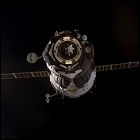 The eighth full-time crew of the International Space Station lifts off from Russia’s Baikonur Cosmodrome aboard Soyuz TMA-3. Alexander Kaleri and Michael Foale take up residence on the ISS for 194 days, both of them veterans of long-term stays aboard the Mir space station; arriving on the ISS with them for a ten-day stay is Spanish astronaut Pedro Duque, who returns to Earth aboard Soyuz TMA-2 with the Expedition 7 crew.
The eighth full-time crew of the International Space Station lifts off from Russia’s Baikonur Cosmodrome aboard Soyuz TMA-3. Alexander Kaleri and Michael Foale take up residence on the ISS for 194 days, both of them veterans of long-term stays aboard the Mir space station; arriving on the ISS with them for a ten-day stay is Spanish astronaut Pedro Duque, who returns to Earth aboard Soyuz TMA-2 with the Expedition 7 crew.
Soyuz TMA-2 / ISS Expedition 7
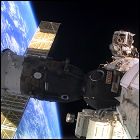 The seventh full-time crew of the International Space Station lifts off from Russia aboard Soyuz TMA-2, a drastic change from their original mission plan. Originally planned to be another short-term “ferry flight” to swap out the station’s Soyuz lifeboat vehicle, Soyuz became the only way to send full-time crews to the station during the post-Columbia-disaster grounding of the American shuttle fleet. Yuri Malenchenko and Ed Lu took up residence aboard the ISS for 184 days, returning in October 2003 with Spanish astronaut Pedro Duque. With the shuttle fleet landlocked, two-man ISS crews became the norm, as three-man crews relied on the greater resupply capacity of the shuttles.
The seventh full-time crew of the International Space Station lifts off from Russia aboard Soyuz TMA-2, a drastic change from their original mission plan. Originally planned to be another short-term “ferry flight” to swap out the station’s Soyuz lifeboat vehicle, Soyuz became the only way to send full-time crews to the station during the post-Columbia-disaster grounding of the American shuttle fleet. Yuri Malenchenko and Ed Lu took up residence aboard the ISS for 184 days, returning in October 2003 with Spanish astronaut Pedro Duque. With the shuttle fleet landlocked, two-man ISS crews became the norm, as three-man crews relied on the greater resupply capacity of the shuttles.
Soyuz TMA-1: the only ride in town
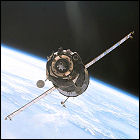 Russia launches a new variant of the venerable Soyuz spacecraft, Soyuz TMA-1, on a mission to the International Space Station. Cosmonauts Sergei Zalyotin and Yury Lonchakov and Belgian astronaut
Russia launches a new variant of the venerable Soyuz spacecraft, Soyuz TMA-1, on a mission to the International Space Station. Cosmonauts Sergei Zalyotin and Yury Lonchakov and Belgian astronaut
Frank De Winne visit the ISS for 11 days, conducting experiments and bringing supplies to the station. This crew returns to Earth aboard Soyuz TM-34, leaving Soyuz TMA-1 at the ISS. When the space shuttle fleet is grounded early in 2003 after the Columbia disaster, Soyuz TMA-1, still berthed at the ISS, becomes the only ride home for the station’s sixth full-time crew.
Soyuz TM-34
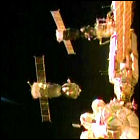 Russia launches a short-term visiting crew to the International Space Station aboard Soyuz TM-34. This is the last Soyuz TM class vehicle to fly, with a newer version of the capsule, Soyuz TMA, scheduled to launch later in 2002. Russian cosmonaut Yuri Gidzenko, Italian astronaut Roberto Vittori, and South African space tourist Mark Shuttleworth comprise Soyuz TM-34’s crew, staying at the ISS for eight days. Like Dennis Tito before him, multi-millionaire and Linux developer Shuttleworth has paid for his own ride into space. This crew leaves the Soyuz TM-34 vehicle at the ISS, returning home aboard Soyuz TM-33.
Russia launches a short-term visiting crew to the International Space Station aboard Soyuz TM-34. This is the last Soyuz TM class vehicle to fly, with a newer version of the capsule, Soyuz TMA, scheduled to launch later in 2002. Russian cosmonaut Yuri Gidzenko, Italian astronaut Roberto Vittori, and South African space tourist Mark Shuttleworth comprise Soyuz TM-34’s crew, staying at the ISS for eight days. Like Dennis Tito before him, multi-millionaire and Linux developer Shuttleworth has paid for his own ride into space. This crew leaves the Soyuz TM-34 vehicle at the ISS, returning home aboard Soyuz TM-33.
Soyuz TM-33
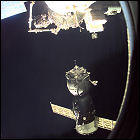 Russia launches Soyuz TM-33 on a mission to the International Space Station. Aboard the Soyuz are cosmonauts Viktor Afanasyev and Konstantin Kozeyev, and French spationaut Claudie Haigneré, making her second visit to a space station (she has previously visited Russia’s Mir space station). This is a short-term visiting crew, spending only eight days aboard Mir and then returning aboard the older Soyuz TM-32 spacecraft, leaving TM-33 as the return vehicle for the next visiting crew.
Russia launches Soyuz TM-33 on a mission to the International Space Station. Aboard the Soyuz are cosmonauts Viktor Afanasyev and Konstantin Kozeyev, and French spationaut Claudie Haigneré, making her second visit to a space station (she has previously visited Russia’s Mir space station). This is a short-term visiting crew, spending only eight days aboard Mir and then returning aboard the older Soyuz TM-32 spacecraft, leaving TM-33 as the return vehicle for the next visiting crew.
Soyuz TM-32: tourism in space
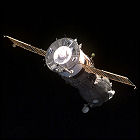 Russia launches Soyuz TM-32 to the International Space Station. Aboard the Soyuz for an eight-day stay on the ISS are cosmonauts Talgat Musabayev and Yuri Baturin, and multi-millionaire space tourist Dennis Tito, the first space traveler to buy his own seat aboard a spacecraft. NASA is less than thrilled with the presence of a “tourist” in space, and refuses to allow Tito to train in advance for activities in the American-built segments of the station. This crew returns to Earth aboard Soyuz TM-31.
Russia launches Soyuz TM-32 to the International Space Station. Aboard the Soyuz for an eight-day stay on the ISS are cosmonauts Talgat Musabayev and Yuri Baturin, and multi-millionaire space tourist Dennis Tito, the first space traveler to buy his own seat aboard a spacecraft. NASA is less than thrilled with the presence of a “tourist” in space, and refuses to allow Tito to train in advance for activities in the American-built segments of the station. This crew returns to Earth aboard Soyuz TM-31.
Soyuz TM-31 / ISS Expedition 1
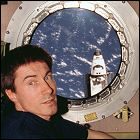 The crew of Soyuz TM-31 spends Halloween in orbit, lifting off from Russia’s Baikonur Cosmodrome on the first long-duration stay aboard the International Space Station. Cosmonauts Yuri Gidzenko and Sergei Krikalev and American astronaut William Shepherd are the first crew to take up residence on the ISS, staying aboard for 136 days. During that stay, they will be visited by the crews of three space shuttles (Endeavour, Atlantis and Discovery), all bringing new hardware modules to the station. This crew returns to Earth aboard Discovery, leaving the Soyuz TM-31 spacecraft as a return vehicle for the next ISS crew.
The crew of Soyuz TM-31 spends Halloween in orbit, lifting off from Russia’s Baikonur Cosmodrome on the first long-duration stay aboard the International Space Station. Cosmonauts Yuri Gidzenko and Sergei Krikalev and American astronaut William Shepherd are the first crew to take up residence on the ISS, staying aboard for 136 days. During that stay, they will be visited by the crews of three space shuttles (Endeavour, Atlantis and Discovery), all bringing new hardware modules to the station. This crew returns to Earth aboard Discovery, leaving the Soyuz TM-31 spacecraft as a return vehicle for the next ISS crew.
Soyuz TM-30: Mir’s final crew
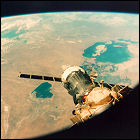 With help from the Russian space program, private corporation MirCorp launches Soyuz TM-30, the final spacecraft to visit the aging Mir space station. Sergei Zalyotin and veteran cosmonaut Aleksandr Kaleri become Mir’s first inhabitants in over eight months, and their mission is to begin refurbishing and repairing the 14-year-old station for what is hoped to be a series of commercial launches, including space tourism and even possibly a reality TV show set aboard Mir. What the two cosmonauts find, however, is that more work will be required than MirCorp can provide; after 72 days, the crew of Soyuz TM-30 returns to Earth, the money having run out before another crew can be sent. Mir will tumble out of its orbit and re-enter Earth’s atmosphere in 2001.
With help from the Russian space program, private corporation MirCorp launches Soyuz TM-30, the final spacecraft to visit the aging Mir space station. Sergei Zalyotin and veteran cosmonaut Aleksandr Kaleri become Mir’s first inhabitants in over eight months, and their mission is to begin refurbishing and repairing the 14-year-old station for what is hoped to be a series of commercial launches, including space tourism and even possibly a reality TV show set aboard Mir. What the two cosmonauts find, however, is that more work will be required than MirCorp can provide; after 72 days, the crew of Soyuz TM-30 returns to Earth, the money having run out before another crew can be sent. Mir will tumble out of its orbit and re-enter Earth’s atmosphere in 2001.
Soyuz TM-29: last call for Mir
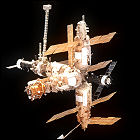 Russia launches Soyuz TM-29 to the Mir space station, carrying an international crew. Cosmonaut Viktor Afanasyev, French spationaut Jean-Pierre Haigneré, and Slovakian cosmonaut Ivan Bella are aboard. Afanasyev and Haigneré take up residence aboard Mir for 188 days, while Bella returns to Earth with Mir’s previous crew aboard Soyuz TM-28 after one week. When Afanasyev and Haigneré return to Earth in August 1999, they bring home cosmonaut Sergei Avdeyev, who by that point has served a full year in orbit aboard Mir. This is the last flight to Mir sponsored by the Russian government, which is now throwing its weight behind the International Space Station, and Mir is left unmanned when Soyuz TM-29 returns to Earth.
Russia launches Soyuz TM-29 to the Mir space station, carrying an international crew. Cosmonaut Viktor Afanasyev, French spationaut Jean-Pierre Haigneré, and Slovakian cosmonaut Ivan Bella are aboard. Afanasyev and Haigneré take up residence aboard Mir for 188 days, while Bella returns to Earth with Mir’s previous crew aboard Soyuz TM-28 after one week. When Afanasyev and Haigneré return to Earth in August 1999, they bring home cosmonaut Sergei Avdeyev, who by that point has served a full year in orbit aboard Mir. This is the last flight to Mir sponsored by the Russian government, which is now throwing its weight behind the International Space Station, and Mir is left unmanned when Soyuz TM-29 returns to Earth.
Soyuz TM-28
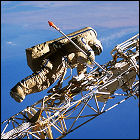 Russia launches Soyuz TM-28 on a mission to the Mir space station, with cosmonauts Gennady Padalka, Sergei Avdeyev and Yuri Baturin aboard. Padalka spends 198 days aboard Mir, conducting further repairs to the station damaged by a 1997 collision with a Progress cargo vehicle, while former politician Baturin remains aboard for 11 days before returning to Earth aboard Soyuz TM-27 with Mir’s previous crew. Avdeyev is aboard Mir for the long haul, spending just over a year in space and not returning to Earth until August 1999.
Russia launches Soyuz TM-28 on a mission to the Mir space station, with cosmonauts Gennady Padalka, Sergei Avdeyev and Yuri Baturin aboard. Padalka spends 198 days aboard Mir, conducting further repairs to the station damaged by a 1997 collision with a Progress cargo vehicle, while former politician Baturin remains aboard for 11 days before returning to Earth aboard Soyuz TM-27 with Mir’s previous crew. Avdeyev is aboard Mir for the long haul, spending just over a year in space and not returning to Earth until August 1999.
Soyuz TM-27
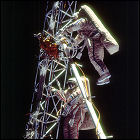 Russia launches the Soyuz TM-27 spacecraft on a mission to the Mir space station. Aboard are cosmonauts Talgat Musabayev and Nikolai Budarin; French spationaut Léopold Eyharts joins them for a 20-day before he returns to Earth with Mir’s previous crew. Musabayev and Budarin remain in orbit on Mir for 207 days, returning to Earth in August 1998 with cosmonaut Yuri Baturin. During their stay, further repairs were conducted to Mir’s solar power panels, which were damaged in a 1997 collision with a Progress unmanned cargo vehicle.
Russia launches the Soyuz TM-27 spacecraft on a mission to the Mir space station. Aboard are cosmonauts Talgat Musabayev and Nikolai Budarin; French spationaut Léopold Eyharts joins them for a 20-day before he returns to Earth with Mir’s previous crew. Musabayev and Budarin remain in orbit on Mir for 207 days, returning to Earth in August 1998 with cosmonaut Yuri Baturin. During their stay, further repairs were conducted to Mir’s solar power panels, which were damaged in a 1997 collision with a Progress unmanned cargo vehicle.
Soyuz TM-26
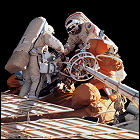 Russia launches Soyuz TM-26 on a mission to the Mir space station, which suffered numerous major malfunctions and damage during its previous crew’s stay. Aboard the Soyuz are specially selected cosmonauts Anatoly Solovyev and Pavel Vinogradov, who have trained on the ground to inspect and repair the damage to the station, though they are unable to find the hull damage to the now-abandoned Spektr module which threatened to cause total decompression of the station. They do manage to restore most of Mir’s solar power generating capability during their 197-day stay, returning to Earth in February 1998 with French spationaut Léopold Eyharts.
Russia launches Soyuz TM-26 on a mission to the Mir space station, which suffered numerous major malfunctions and damage during its previous crew’s stay. Aboard the Soyuz are specially selected cosmonauts Anatoly Solovyev and Pavel Vinogradov, who have trained on the ground to inspect and repair the damage to the station, though they are unable to find the hull damage to the now-abandoned Spektr module which threatened to cause total decompression of the station. They do manage to restore most of Mir’s solar power generating capability during their 197-day stay, returning to Earth in February 1998 with French spationaut Léopold Eyharts.
Soyuz TM-25
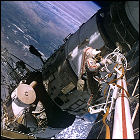 Russian cosmonauts Vasili Tsibliyev and Aleksandr Lazutkin lift off aboard Soyuz TM-25 for an eventful mission aboard Russian space station Mir. Tagging along is German space traveler Reinhold Ewald, who will remain in space for 19 days before returning to Earth with Mir’s previous crew aboard Soyuz TM-24; Tsibliyev and Lazutkin will later be joined by American shuttle astronaut Jerry Linenger. Their 184-day stay is marred by numerous emergencies aboard the station, ranging from a fire in the station’s cramped quarters to a collision with an unmanned Progress cargo spacecraft, which Russian ground controllers are initially eager to keep quiet from the rest of the world.
Russian cosmonauts Vasili Tsibliyev and Aleksandr Lazutkin lift off aboard Soyuz TM-25 for an eventful mission aboard Russian space station Mir. Tagging along is German space traveler Reinhold Ewald, who will remain in space for 19 days before returning to Earth with Mir’s previous crew aboard Soyuz TM-24; Tsibliyev and Lazutkin will later be joined by American shuttle astronaut Jerry Linenger. Their 184-day stay is marred by numerous emergencies aboard the station, ranging from a fire in the station’s cramped quarters to a collision with an unmanned Progress cargo spacecraft, which Russian ground controllers are initially eager to keep quiet from the rest of the world.
Soyuz TM-24
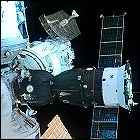 Soyuz TM-24 is launched from Russia, on a mission to dock with the Mir space station. Aboard are cosmonauts Valery Korzun and Aleksandr Kaleri, who stay aboard Mir for 196 days, and visiting French spationaut Claudie André-Deshays, the first French woman in space, who stays aboard Mir for 16 days before returning to Earth with the station’s previous crew aboard Soyuz TM-23. Korzun and Kaleri will return to Earth in March 1997.
Soyuz TM-24 is launched from Russia, on a mission to dock with the Mir space station. Aboard are cosmonauts Valery Korzun and Aleksandr Kaleri, who stay aboard Mir for 196 days, and visiting French spationaut Claudie André-Deshays, the first French woman in space, who stays aboard Mir for 16 days before returning to Earth with the station’s previous crew aboard Soyuz TM-23. Korzun and Kaleri will return to Earth in March 1997.
Soyuz TM-23
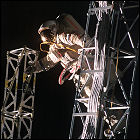 Russia launches the Soyuz TM-23 mission to the Mir space station. The crew, cosmonauts Yuri Onufrienko and Yury Usachov, remain aboard Mir for 193 days, returning to Earth in September 1996 with French spationaut Claudie André-Deshays.
Russia launches the Soyuz TM-23 mission to the Mir space station. The crew, cosmonauts Yuri Onufrienko and Yury Usachov, remain aboard Mir for 193 days, returning to Earth in September 1996 with French spationaut Claudie André-Deshays.
Soyuz TM-22
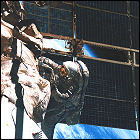 Russia launches the Soyuz TM-22 mission to space station Mir, carrying cosmonauts Yuri Gidzenko and Sergei Avdeyev from Russia, and Thomas Reiter from Germany. The three space travelers settle in for a 179-day stay aboard Mir, from which they will return early in 1996.
Russia launches the Soyuz TM-22 mission to space station Mir, carrying cosmonauts Yuri Gidzenko and Sergei Avdeyev from Russia, and Thomas Reiter from Germany. The three space travelers settle in for a 179-day stay aboard Mir, from which they will return early in 1996.
Soyuz TM-21
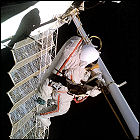 An American astronaut lifts off aboard a Russian Soyuz spacecraft for the first time ever with the launch of Soyuz TM-21, a mission to the Mir space station. Cosmonauts Vladimir Dezhurov and Gennady Strekalov are joined by astronaut Norman Thagard aboard Mir, where they remain for 115 days. During that time, they witness the arrival of the Spektr module, a new addition to the station, and they ultimately return to Earth aboard space shuttle Atlantis in July 1995; Soyuz TM-21 remains at the station, where a future Mir crew uses it to return to Earth. During the Atlantis mission, a new record is set for the number of humans in space, as the station and shuttle crews add up to 13 people in orbit at once.
An American astronaut lifts off aboard a Russian Soyuz spacecraft for the first time ever with the launch of Soyuz TM-21, a mission to the Mir space station. Cosmonauts Vladimir Dezhurov and Gennady Strekalov are joined by astronaut Norman Thagard aboard Mir, where they remain for 115 days. During that time, they witness the arrival of the Spektr module, a new addition to the station, and they ultimately return to Earth aboard space shuttle Atlantis in July 1995; Soyuz TM-21 remains at the station, where a future Mir crew uses it to return to Earth. During the Atlantis mission, a new record is set for the number of humans in space, as the station and shuttle crews add up to 13 people in orbit at once.
Soyuz TM-20
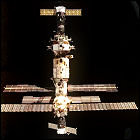 Russia launches the Soyuz TM-20 mission to space station Mir, carrying cosmonauts Alexander Viktorenko and Yelena Kondakova, and German astronaut Ulf Merbold, who will remain for only a month to conduct experiments in orbit. A glitch in the automated docking system forces Viktorenko to assume manual control for the docking with Mir, a problem which will plague future Mir crews. Viktorenko and Kondakova remain aboard Mir for 169 days, returning to Earth in March 1995 with the new space endurance world record holder, Dr. Valery Polyakov, who has spent 437 days in orbit.
Russia launches the Soyuz TM-20 mission to space station Mir, carrying cosmonauts Alexander Viktorenko and Yelena Kondakova, and German astronaut Ulf Merbold, who will remain for only a month to conduct experiments in orbit. A glitch in the automated docking system forces Viktorenko to assume manual control for the docking with Mir, a problem which will plague future Mir crews. Viktorenko and Kondakova remain aboard Mir for 169 days, returning to Earth in March 1995 with the new space endurance world record holder, Dr. Valery Polyakov, who has spent 437 days in orbit.
Soyuz TM-19
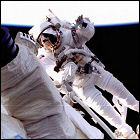 Soyuz TM-19 lifts off from Kazakhstan, on a mission to the Russian space station Mir with cosmonauts Yuri Malenchenko and Talgat Musabayev aboard. Over the course of their 125-day stay, the crew joins Dr. Valery Polyakov aboard Mir, in the middle of his record-shattering 437-day stay in space. Malenchenko and Musabayev conduct 11 hours worth of spacewalks to repair Mir’s exterior insulation and other minor maintenance, and returns home in November 1994 with German astronaut Ulf Merbold.
Soyuz TM-19 lifts off from Kazakhstan, on a mission to the Russian space station Mir with cosmonauts Yuri Malenchenko and Talgat Musabayev aboard. Over the course of their 125-day stay, the crew joins Dr. Valery Polyakov aboard Mir, in the middle of his record-shattering 437-day stay in space. Malenchenko and Musabayev conduct 11 hours worth of spacewalks to repair Mir’s exterior insulation and other minor maintenance, and returns home in November 1994 with German astronaut Ulf Merbold.
A close call at Mir
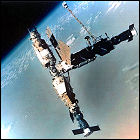 The departing crew of Soyuz TM-17, cosmonauts Vasili Tsibliyev and Aleksandr Serebrov, board their capsule and vacate the Russian Mir space station, as planned. Ordered to take photos of the new docking assembly that will someday allow American space shuttles to visit Mir, Tsibliyev brings the Soyuz back to a close distance from the station, but complains of sluggish controls – just before Soyuz collides with the station, bouncing off of its outer hull twice. Mir’s newly arrived crew prepares to evacuate in their own Soyuz, but no critical damage is found to either the station or to Soyuz TM-17, which is allowed to return home. Tsibliyev’s luck aboard Mir will only get worse during his troubled second tour of duty on the station later in the 1990s.
The departing crew of Soyuz TM-17, cosmonauts Vasili Tsibliyev and Aleksandr Serebrov, board their capsule and vacate the Russian Mir space station, as planned. Ordered to take photos of the new docking assembly that will someday allow American space shuttles to visit Mir, Tsibliyev brings the Soyuz back to a close distance from the station, but complains of sluggish controls – just before Soyuz collides with the station, bouncing off of its outer hull twice. Mir’s newly arrived crew prepares to evacuate in their own Soyuz, but no critical damage is found to either the station or to Soyuz TM-17, which is allowed to return home. Tsibliyev’s luck aboard Mir will only get worse during his troubled second tour of duty on the station later in the 1990s.
Soyuz TM-18
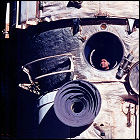 Russian spacecraft Soyuz TM-18 lifts off from Baikonur Cosmodrome in Kazakhstan, on a mission to the Russian space station Mir. Aboard the Soyuz are cosmonauts Viktor Afanasyev, Yuri Usachov, and Dr. Valeri Polyakov, a medical doctor who will study the effects of long-duration spaceflight on the crew (including himself). Following a scary close call with the previous crew’s wayward Soyuz, the TM-18 crew settles in for a 182-day stay, with Afanasyev and Usachov returning to Earth; Polyakov remains aboard Mir, where he will eventually set the human space endurance record with a 420-day stay in orbit.
Russian spacecraft Soyuz TM-18 lifts off from Baikonur Cosmodrome in Kazakhstan, on a mission to the Russian space station Mir. Aboard the Soyuz are cosmonauts Viktor Afanasyev, Yuri Usachov, and Dr. Valeri Polyakov, a medical doctor who will study the effects of long-duration spaceflight on the crew (including himself). Following a scary close call with the previous crew’s wayward Soyuz, the TM-18 crew settles in for a 182-day stay, with Afanasyev and Usachov returning to Earth; Polyakov remains aboard Mir, where he will eventually set the human space endurance record with a 420-day stay in orbit.
Soyuz TM-17
 The Russian spacecraft Soyuz TM-17 lifts off from Kazakhstan, bound for space station Mir. Cosmonauts Vasili Tsibliyev, Aleksandr Serebrov replace the incumbent station crew, staying aboard Mir for 196 days, while Jean-Pierre Haigneré returns to Earth with the previous Mir crew aboard Soyuz TM-16 after a three-week stay. When the crew leaves Mir in January 1994, their departure is anything but routine, as Tsibliyev is unable to prevent a collision between Mir and the departing Soyuz.
The Russian spacecraft Soyuz TM-17 lifts off from Kazakhstan, bound for space station Mir. Cosmonauts Vasili Tsibliyev, Aleksandr Serebrov replace the incumbent station crew, staying aboard Mir for 196 days, while Jean-Pierre Haigneré returns to Earth with the previous Mir crew aboard Soyuz TM-16 after a three-week stay. When the crew leaves Mir in January 1994, their departure is anything but routine, as Tsibliyev is unable to prevent a collision between Mir and the departing Soyuz.
Soyuz TM-16: getting Mir ready for company
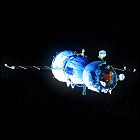 Cosmonauts Gennadi Manakov and Alexander Poleshchuk lift off aboard Soyuz TM-16, on a course for Russian space station Mir. In preparation for the upcoming joint international missions that will see American space shuttles docking with Mir, Soyuz TM-16 carries a new type of docking mechanism designed to test the docking port that will be used by visiting shuttles. Manakov and Poleshchuk remain aboard Mir for 179 days, returning to Earth in July 1993 with French spationaut Jean-Pierre Haigneré.
Cosmonauts Gennadi Manakov and Alexander Poleshchuk lift off aboard Soyuz TM-16, on a course for Russian space station Mir. In preparation for the upcoming joint international missions that will see American space shuttles docking with Mir, Soyuz TM-16 carries a new type of docking mechanism designed to test the docking port that will be used by visiting shuttles. Manakov and Poleshchuk remain aboard Mir for 179 days, returning to Earth in July 1993 with French spationaut Jean-Pierre Haigneré.